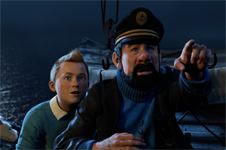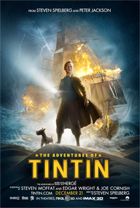The Adventures of Tintin
|  Following in the footsteps of his former protégé Robert Zemeckis, who hasn’t directed a live actor on film since Tom Hanks talked to a volleyball in Cast Away (2000), Steven Spielberg has ventured into the world of 3D performance capture CGI with The Adventures of Tintin, which is drawn from the much-loved (although mostly outside the United States) comic book series by the Belgian author and illustrator Hergé. This would seem to fly in the face of Spielberg’s many proclamations of his love and dedication to old-fashioned 35mm celluloid, which he insists he will continue to use until the last film processing lab closes. Ironic, then, that he has now made a digital film that not only foregoes shooting on celluloid, but dispenses with the entire concept of “shooting” altogether, instead relying on the technological process of replacing flesh and blood with digital pixels and generating entire worlds inside banks of computers without anyone looking through something so primitive as a lens. Following in the footsteps of his former protégé Robert Zemeckis, who hasn’t directed a live actor on film since Tom Hanks talked to a volleyball in Cast Away (2000), Steven Spielberg has ventured into the world of 3D performance capture CGI with The Adventures of Tintin, which is drawn from the much-loved (although mostly outside the United States) comic book series by the Belgian author and illustrator Hergé. This would seem to fly in the face of Spielberg’s many proclamations of his love and dedication to old-fashioned 35mm celluloid, which he insists he will continue to use until the last film processing lab closes. Ironic, then, that he has now made a digital film that not only foregoes shooting on celluloid, but dispenses with the entire concept of “shooting” altogether, instead relying on the technological process of replacing flesh and blood with digital pixels and generating entire worlds inside banks of computers without anyone looking through something so primitive as a lens.The story combines elements from three of Hergé’s 23 Tintin adventures: The Crab With the Golden Claws (1941), The Secret of the Unicorn (1943), and Red Rackham’s Treasure (1944). We are introduced to Tintin (Jaime Bell), the titular boy reporter given to powder-blue sweaters and brown knickers, walking through a picturesque outdoor market in an unnamed European town. There he purchases a model ship from a street vendor, which is promptly stolen from his flat, thus leading him into a complex mystery involving the location of a sunken 17th-century ship carrying a cargo of gold and jewels. His partner in the search is Captain Haddock (Andy Serkis), a blustery, frequently inebriated sea captain whose family lineage can be traced back to the sunken vessel. The villain is Ivan Sakharine (Daniel Craig), a vicious aristocrat whose own family lineage traces back to the pirate who caused the sinking of the ship 300 years ago. Thus, the two descendents each feel rightful claim to the lost gold, and they compete to collect the vital clues (including a slip of paper hidden in the mast of Tintin’s model ship) that together point to the treasure’s final resting place. It was widely reported that, after seeing Raiders of the Lost Ark (1981), Hergé (who died in 1983) said that Spielberg was the only filmmaker who could do Tintin justice on screen (there had been several attempts over the years to cinematize Tintin’s adventures, including cell animation, stop-motion animation, and even live action). Although Spielberg was literally “the man for the job,” it turns out that the free reign offered by CGI has short-circuited much of his artistry in favor of a hectic sense of constant movement, action, and slapstick humor. There are certainly glimpses of Spielbergian action at its finest, particularly an single-shot chase sequence involving a motorcycle, a bazooka, a broken dam, and a trained hawk, but much of it is simply frenzied beyond enjoyment. The action is dazzling in terms of overwhelming your senses, but it is rarely awe-inspiring; it doesn’t grab you by the throat or rattle your nerves like Spielberg’s best work, and it lacks his instinct for feeling. It’s too calculated by half. The many comparisons being made between Tintin and Raiders are plagued by historical amnesia regarding the latter’s gritty physicality and its perfectly maintained rhythm of choreographed chaos and character-driven respite. A better comparison would be to 1941 (1979), Spielberg’s grandiose ode to slapstick comedy whose primary sin was overindulgence. Given Tintin’s origins in comic books, the CGI-animation approach is arguably justified, unlike several of Zemeckis’s performance capture films like Beowulf (2007), which needlessly replaced human actors with similar-looking digital avatars. Tintin also avoids the “uncanny valley” in that the characters, while photorealistic down to their skin pores and nose hairs, are given just enough cartoonish dimensions (Tintin’s cowlick, Captain Haddock’s bulbous nose) to escape the waxen creepiness of the zombie children in The Polar Express (2004). They remain relatively flat in terms of characterization, though, which isn’t too surprising in Tintin’s case since he has always been a cipher of idealism, honesty, and tenacity (Hergé has said in interviews that his greatest influence in life was the Boy Scouts). It is disappointing, though, that the action tends to drown out any contribution beyond mere page-to-screen translation by the film’s robust British screenwriting team, comprised of Steven Moffat, a veteran television writer who has contributed substantially to the BBC’s resurrection of Doctor Who (2005–); Edgar Wright, the sharp-witted writer/director behind Scott Pilgrim vs. the World (2010) and Hot Fuzz (2008); and Joe Cornish, the fast-rising young writer/director whose Spielberg-alluding urban sci-fi-comedy Attack the Block (2011) has been critically praised on both sides of the Atlantic. Their voices, along with Spielberg’s and producer Peter Jackson’s, are effectively lost in the digital swirl. As both a director and producer Spielberg has always been a technologically savvy filmmaker working on the cutting edge, and his films from the past three decades are a literal history lesson in the development of modern special effects, including CGI. Yet, looking back at his previous, technologically groundbreaking films, you get the sense that the technology is at the service of the movie, rather than the other way around; Tintin plays like it is driven by computers. The inherent limitations of practical, physical effects have created some of Spielberg’s most enthralling action sequences: the laborious, frequently malfunctioning mechanical shark in Jaws (1975), the live stunts in the early Indiana Jones movies, even the need to combine limited amounts of CGI with animatronics in Jurassic Park (1993). Now that he can do literally anything in the digital world—physics be damned!—there is a loss of essence, a curtailing of the primary excitement of getting lost in Spielberg’s spectacle and the secondary excitement of wondering how, exactly, he pulled it off. For a reminder of what that excitement feels like, slip into the theater next door and see Tom Cruise, who collaborated with Spielberg on the thoughtful sci-fi thriller Minority Report (2002) and the traumatic blockbuster War of the Worlds (2005), clinging to the outside of Dubai’s 160-story Burj Khalifa in Mission: Impossible—Ghost Protocol. It is interesting and telling that Ghost Protocol is the live-action debut of director Brad Bird, who has previously worked only in animation, while Tintin is effectively Spielberg’s animation debut. Bird gets it right by drawing from the limitlessness of the animated world and making it work within the constraints of live action, while Spielberg gets lost in his newfound freedom, giving us so much mayhem and movement that the film feels more exhausting than exhilarating. Copyright ©2011 James Kendrick Thoughts? E-mail James Kendrick All images copyright © Paramount Pictures and DreamWorks SKG |
Overall Rating: 
 (2)
(2)


